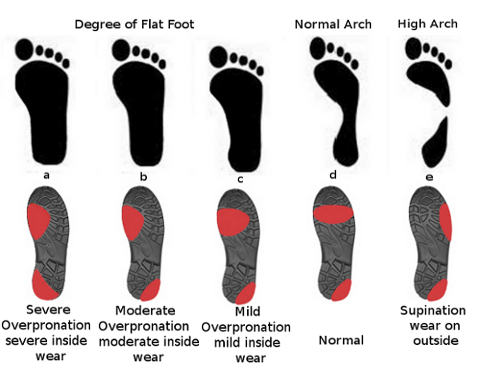The Anatomy of a Shoe
You might think of your shoes as just another part of your wardrobe. However, your shoes are an important part to the health of your feet. By selecting a shoe that is well constructed and properly sized for your feet, you can help improve your overall foot health. |
Components of a shoe
Although you might not think about it, your shoes are made up of various components. In many cases, the construction and fit of these individual components can either improve your foot health or lead to injury and certain foot ailments. Toe Box As its name implies, the toe box is the part of the shoe that covers your toes. Toe boxes can be wide or narrow and may be pointed, rounded, or squared. To best avoid issues, your toe box should be wide and long enough to allow you to wiggle your toes. A toe box that is too small can cause numerous issues, including: Bruised Toenails, Bunions, and Hammertoes Sole The sole is the bottom part of the shoe. It is sometimes referred to as two separate pieces: insole and outsole. The insole is the part of the shoe that has direct contact with the bottom of your foot. The shoe's outsole is the portion that contacts the ground when you walk. Softer soles can better absorb shock; however, this is not always the best option, for activities like cycling you would want a firmer sole. In most cases, you want the sole of your shoe to be flexible while still providing support. Too much or too little support can lead to foot pain. Heel The heel is located at the back of the shoe and it adds height to the shoe. For better foot health, it is recommended that you wear a shoe with a low heel (preferably half of an inch or smaller) and a wide toe box. However, you may be tempted by the fashion of high heels. It is important to note that high heels can lead to numerous problems, including: Achillies Tendinitis, Ankle Sprains and Strains, Blisters, Corns, Calluses, Bone Spurs, Haglund's Deformity, Metatarsalgia, Neruomas Vamp The vamp is the top and middle section of your shoe, typically where laces, Velcro, or straps would be. The vamp should provide adequate support to ensure that your foot does not slip out of the shoe, as this can lead to an ankle sprain.
|
Wear PatternsShoes are not meant to last forever. Over time, you will begin to notice the erosion of the sole of your shoes, as well as other changes in the structure of your shoes. These wear patterns can help determine if you have a proper gait (walk). They can also detect problems with your feet.
|
Various wear patterns Wear patterns can be seen on the: |
Using wear patterns to detect foot problems By examining the wear patterns on your shoe, a skilled podiatrist might find issues with either your foot's functioning or the way you walk. Some of these issues can be corrected simply by purchasing orthotics or the correct shoes for your activity. Other foot problems might need additional treatment. Some problems your podiatrist can diagnose from your shoe's wear patterns include:
|
Types of Shoes
Not all shoes are created equal. Some shoes are designed simply for style and do not give you the comfort and support you need to avoid injury, feet deformities, or other conditions.It is possible to find stylish shoes that do not hurt your feet; you just need to know how to find them. Learn more about the importance of proper shoes and how to select the best footwear for your needs:

